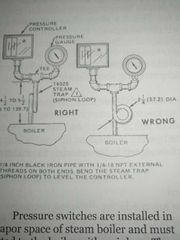![]()
![]()
![]()
Use LEFT and RIGHT arrow keys to navigate between flashcards;
Use UP and DOWN arrow keys to flip the card;
H to show hint;
A reads text to speech;
20 Cards in this Set
- Front
- Back
|
What is the flu temperature, for a standard efficient, furnace or Appliance. |
470 degrees Fahrenheit |
|
|
How did a ,standard furnace, become a mid efficient ,furnace. This is still, just a category 1 Appliance. Non condensing. |
By lengthening the, passages in heat - exchanger, and narrowing, the flu passage as well. And Now they needed to add, a fan to draw, products of combustion, through the reduced heat exchanger.AndBy removing, the standing, pilot. The appliance went from 55% efficiency, to 80 to 85%, efficiency. AndBy removing, the standing, pilot. The appliance went from 55% efficiency, to 80 to 85%, efficiency. By removing, the standing, pilot. The appliance went from 55% efficiency, to 80 to 85%, efficiency. |
|
|
Is the pressure in the venting, of a mid efficient furnace positive or negative. |
B type venting still used, and the pressure is negative. Convection still moves the, products of combustion up the chimney. This is still just, a category 1 Appliance non condensing. |
|
|
What is RTV. |
Room temperature Vulcanizing silicone. Must have 24 hours to dry. |
|
|
A category 3, mid efficient Appliance. How are the evented and do they produce some condensation? |
Condensation is in the vent. Venting must be made of, a material specified, by the manufacturer or ,stainless steel. A drain must be applied, to the venting, A trap must be placed in the ,drain portion stop flue gases, from entering the home, condensation must be treated, by a neutralizer. These are, positive pressure vent, joints must be sealed. |
|
|
What is the ratio between, the ground rod and the, flame rod for, microamps DC. |
The ground, must be larger than ,the rod by four times, 4 to 1. |
|
|
Name the 4, most common, ignition systems. |
Intermittent pilot using a spark. intermittent pilot using a hot surface ignitor. Direct ignition using a spark. Or direct ignition using a hot surface ignitor. Interrupted pilot systems are still out there but not used anymore. |
|
|
What is the temperature of a hot surface ignitor. |
2600 degrees Fahrenheit. Or 1427 degrees Celsius. |
|
|
What is the spark ignition voltage in kilovolt. And what is the temperature |
13 kilovolts. 12 to 15,000 degrees Fahrenheit |
|
|
What's the maximum amount, of gas and intermittent pilot, can burn compared to the, main burner imput. |
No more than 5%, of the input of the main burner. |
|
|
Why have flame conductivity systems, not been used, for proving the flame. |
The system will not, distinguish between a flame, and a short to ground. |
|
|
Air Supply definition. |
The total air used, for a gas-fired Appliance. It includes combustion air, primary air, secondary air, excess air, dilution and ventilation air. |
|
|
Combustion air definition. |
Air for combustion of the fuel gases. It includes primary, secondary air ,and excess air. |
|
|
Primary air definition. |
Air that is entrained, at the primary air shutter, and mixes with the gas prior, to combustion. It's supplied for the , initial stage of combustion, and accounts for approximately, 60%, of the products of combustion. |
|
|
Secondary air definition. |
Air that is added, to the flame, at the point of combustion. It is supplied for, the intermediate and final stages, of combustion. And accounts for, approximately 40%, of the products of combustion. |
|
|
Excess air definition. |
Although it is not theoretically ,required for combustion. It is a part of, combustion air ,and some may be used. This air accounts for approximately, 40% of primary and secondary air. Primary and secondary air make up 100% of the air. this AIDS in that 100%. |
|
|
Dilution air definition |
This makes up approximately 50% ,of the volume ,of air moving up the ventilation, diluting the heat from the appliance. |
|
|
Ventilation air only required for. Appliances exceeding 400,000 BTU. Definition |
Hear that pertains , to the installation of appliances, 4 the ventilation of the space containing appliances. This opening ,allows for spilled products of combustion ,and excess heat to dissipate. |
|

Steam boiler ,main scale,and differential. Must be mounted this way. |
Must be mounted ,this way. If mounted ,the opposing Direction, the tube will stretch ,and tip the control, the Mercury switch ,will not be accurate. |
|
|
Done |
Done |

